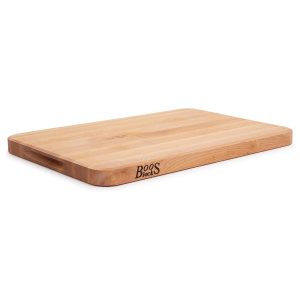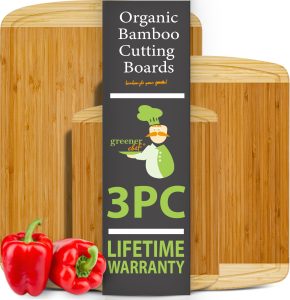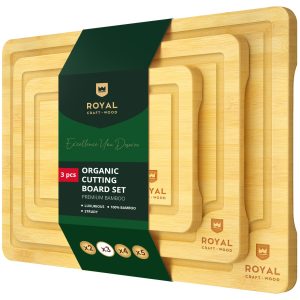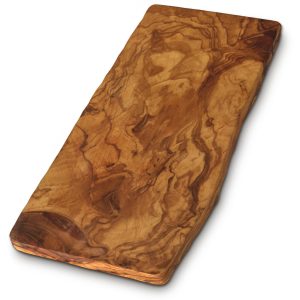Elevate your kitchen safety with our selection of non-toxic cutting boards, essential for health-conscious cooks. These boards, ranging from bamboo to hardwoods and eco-friendly composites, ensure food safety without chemical contamination.
Within the category of non-toxic cutting boards, options range from organic bamboo to various wood types, and even some innovative composite materials. Bamboo cutting boards, for example, are often touted for their sustainability and natural resistance to bacteria.
Hardwoods like maple and walnut are prized for their durability and natural beauty, while certain composites claim a space in the market for their eco-friendliness and low maintenance qualities.
Our guide focuses on the best non-toxic cutting boards that excel in durability, maintenance ease, and bacteria resistance.

Best Non-Toxic Cutting Boards
Our team has carefully researched and evaluated a variety of cutting boards to bring you our selection of the top non-toxic options. Each product on our list is chosen for its durability, ease of maintenance, and eco-friendly properties, aligning with our commitment to health and environmental responsibility.
1. Boos Block Maple Board
We found this board integrates seamlessly into any kitchen routine, whether you’re a seasoned chef or a home cook.
Pros
- Superior craftsmanship with durable American maple wood
- Reversible design doubles the usable surface
- Natural oil finish enhances the wood’s longevity
Cons
- Requires regular maintenance with mineral oil
- Not dishwasher safe, hand wash only
- Higher price point due to quality materials
Having recently prepared a feast for friends, we were reminded of the significance of a dependable cutting surface. The Boos Block Maple Board served as a reliable workhorse throughout the evening, effortlessly accommodating our slicing and dicing needs.
Its weight and sturdiness became evident as we breezed through piles of vegetables and hunks of meat without a single slip or shift of the board.
This board’s visual appeal is immediately striking. The rich grain of the maple brings a touch of elegance to the kitchen counter, making it not just a utility item but a conversation piece. Throughout its use, it’s also spared the sharp edges of our knives the brash damage other boards might inflict, preserving them for longer and ensuring smooth cuts.
In using the Boos Block Maple Board, we did notice it needed some attention to maintain its splendor. A periodic rubdown with mineral oil kept it looking fresh and prevented the wood from drying out. While this might be seen as an inconvenience, the resultant prolonging of the board’s life and pristine condition justifies the effort.
In a sea of cutting boards, the Boos Block Maple Board stands out for its quality and function. For those who take their culinary tools seriously, the investment is met with a resilient and reliable partner in the kitchen.
2. Virginia Boys Walnut Board
We think this board is a standout option for its beauty and functionality, making it a worthwhile addition to any kitchen.
Pros
- Crafted from sustainable black walnut wood, offering both durability and a touch of elegance
- Features a juice well to capture liquids, keeping your countertop clean during use
- Reversible design means you can use both sides, effectively doubling its lifespan
- Made in USA
Cons
- Higher price point than some other cutting boards on the market
- Requires regular maintenance with oil to retain its appearance and prevent drying
- Not dishwasher safe; hand wash only which may be inconvenient for some
When first using this cutting board, the feeling of the smooth walnut wood under your knife is satisfying. It has a substantial feel without being overly heavy, suggesting quality craftsmanship and material. The built-in groove is invaluable, catching runaway juices when I’m carving meat or slicing tomatoes, which maintains a tidy work surface.
The visual appeal of this board is undeniable. It’s not just a kitchen tool; it’s a piece of decor. It looks fantastic when used as a charcuterie board, its rich, dark tones providing a perfect backdrop for cheeses and meats. After a light oiling, the grain pops, highlighting its natural beauty.
We’ve noticed that the extra care the board necessitates is actually a testament to its quality. Comparing it to other cutting boards, the feel of the knife on the wood is gentler, which I’ve found keeps my knives sharper for longer. Its double-sided feature means I can use one side for raw meats and the other for vegetables, avoiding cross-contamination.
Overall, the Virginia Boys Walnut Board has proven itself to be more than just a surface for chopping vegetables. It’s an investment in our kitchen’s aesthetics and functionality. While the upkeep may deter some, we believe the payoff in craftsmanship and longevity justifies the effort.
3. Greener Chef Bamboo Trio
Our kitchens deserve the safest tools, which is why this Greener Chef bamboo cutting board set, with its non-toxic advantage, comes highly recommended.
Pros
- Lifetime guarantee promotes peace of mind
- Versatile set caters to all chopping needs
- Bamboo material offers durability and knife protection
Cons
- Requires regular maintenance with oil
- Not dishwasher-safe implies manual cleaning
- No handles for hanging may limit storage options
We’ve explored numerous cutting boards, and the Greener Chef Trio stands out. Their robust construction endures daily slicing and dicing without dulling knives. During a busy meal prep, the deep juice grooves prove invaluable, catching runaway liquids from tomatoes or meats. The three sizes ensure there’s always the right board for the task, whether filleting fish or quartering fruits.
Aesthetics matter in kitchenware, and these boards impress with their two-tone bamboo warmth. They double as elegant charcuterie or cheese boards for hosting. Transitions from kitchen to dining are seamless, enhancing the culinary experience.
The organic bamboo material underlines our commitment to a healthier, more sustainable kitchen environment. However, be prepared to give these boards some tender loving care. They crave regular conditioning with a specific oil to maintain their luster and functionality. Despite this, they clean up quickly and effortlessly by hand after each use.
In sum, our experience confirms that the Greener Chef Bamboo Cutting Board Set is a worthy addition to any kitchen, promoting both culinary efficiency and environmental consciousness.
4. Bamboo Board Trio
Our kitchen routines have been effortlessly elevated by these versatile, non-toxic bamboo cutting boards.
Pros
- Diverse sizes cater to various culinary tasks
- Convenient handles make transport easy
- Gentle on knife edges, preserving their sharpness
Cons
- Bamboo may not withstand heavy-duty butchering
- Requires hand washing and care for longevity
- Not as durable as some heavier hardwood boards
Chopping on these boards feels smooth and efficient, a testament to the quality of bamboo used. The variety of sizes in this set means we’ve always had the right board for the task, whether dicing veggies or serving up cheese and crackers. Knife-friendly? Absolutely, and that’s a win for any cooking enthusiast keen on keeping their blades in top shape.
The built-in handles these boards boast are a standout feature, easing the transition from cutting to cooking. They’ve also doubled as stylish serving platters; the natural bamboo grain is quite the conversation starter when we bring out appetizers.
We’ve noticed the deep juice grooves to be particularly effective at keeping our countertops clean. It’s one less thing to stress about as juices from fruits or meats stay contained, not to mention the easy transfer of prepped food straight into the pot, thanks to these thoughtful grooves.
The commitment of ROYAL CRAFT WOOD to its customers shone through their durable yet aesthetically pleasing design, a non-toxic choice for our health and the environment. While these boards require a bit more TLC compared to plastic alternatives, the extra effort has been a trade-off we’re willing to make for the quality and peace of mind they provide.
5. Olive Wood Charcuterie Board
We believe this board is a standout choice for those who value artisan craftsmanship and natural materials in their kitchen essentials.
Pros
- Crafted from robust olive wood for durability and aesthetics
- Double-duty design suitable for both serving and cutting
- Unique live edge adds a touch of rustic elegance to any setting
Cons
- Hand wash only, not suitable for dishwasher
- Natural variation means each piece is distinct, which may not suit those seeking uniformity
- Due to its artisan nature, availability might be limited
Having just had the opportunity to test this board, we were immediately struck by the artistry in its design; the naturally occurring patterns in the wood make each piece unique. Chopping vegetables was a pleasure, as our knives glided smoothly across the surface without any hint of dulling. The board’s finish seemed to resist moisture well, and it doubled as an attractive serving platter for cheese and fruits.
After using it, though, it was clear that maintenance is key. Hand washing is a must to preserve the integrity of the olive wood, a task that, while not difficult, requires a bit more time compared to other kitchen tools. Despite its sturdiness, we found ourselves treating the board with extra care to maintain its natural luster.
Lastly, we noticed something special when serving guests; the board was often a conversation starter. Its live edge offers a unique look that stands out from the typical straight-edge designs. However, we recommend prompt acquisition if you’re captivated by its charm, as artisan products like this may not always be readily available.
6. NoTrax Sani-Tuff Small Rubber Board
We think this compact NoTrax Sani-Tuff board is a fantastic option for those in need of a durable, rubber cutting surface that’s easy on knives and won’t harbor bacteria or odors.
Pros
- Protects your knife’s edge with its soft rubber composition
- Resists stains, doesn’t absorb odors or bacteria
- Stays put on countertops, thanks to its non-slip nature
Cons
- The small size isn’t suitable for larger food prep tasks
- Has a distinct rubber odor upon unpacking
- Cannot be cleaned in the dishwasher, hand wash only
Chopping garlic and dicing shallots has become a more pleasant experience with this NoTrax cutting board. Its rubber construction offers just the right amount of give, so our knives stay sharper longer. We’ve noticed an improvement in our knife’s longevity since using it.
The board’s natural resilience to stains and odors is something we can vouch for. After slicing onions and marinated meats, a simple wash left no lingering smells. We appreciate its commitment, ensuring our board remains as fresh as the day we bought it.
However, it’s important to note the compact size of this board. For small tasks, it shines, but it’s quite limiting when tackling more sizeable kitchen duties. Plus, we found we needed to air it out due to the rubbery scent it emitted initially. Despite that, the stability and longevity of the NoTrax Sani-Tuff board make these small inconveniences worth it.
Buying Guide
When selecting a non-toxic cutting board, we consider material, size, and maintenance.
Material
The material of the cutting board is pivotal for both safety and durability.
- Wood: Natural and durable with self-healing properties. Look for hardwoods like maple or walnut.
- Bamboo: Harder than some woods and eco-friendly, but can dull knives quicker.
- Natural rubber: Offers a softer, knife-friendly surface and is biodegradable, making it an excellent eco-conscious choice. However, it may not be as durable as wood or composite options.
- Composite: A blend of resins and wood fibers that offers durability and is dishwasher-safe.
- Silicone: Flexible and usually heat-resistant, though not as tough as wood or composite.
Note: While composite and silicone cutting boards offer unique advantages such as dishwasher safety and flexibility, natural materials like wood and natural rubber are often preferred for their inherent non-toxic qualities. These natural options are generally safer and more environmentally friendly choices for those prioritizing health and sustainability in their kitchenware.
Size
Choose a size that accommodates the foods you commonly prepare and fits well in your kitchen space.
- Small (6″-9″): For quick jobs or small kitchens.
- Medium (10″-14″): A versatile choice for everyday use.
- Large (15″+): For large tasks or professional use.
Maintenance
Consider the ease of maintenance to keep the cutting board in optimal condition.
- Oil regularly for wood and bamboo to prevent drying and cracking.
- Dishwasher-safe options for composite and silicone ease cleaning.
- Surface texture: A board with a fine grain or smooth surface can be easier to clean.
Features
Some additional features to look for:
- Non-slip edges to stabilize the board during use.
- Juice grooves to catch liquids and keep the workspace clean.
- Reversible sides for versatile use or to prevent cross-contamination.
By assessing these aspects carefully, we can choose a non-toxic cutting board that will be safe for food preparation and last us for years to come.
FAQ
In this section, we address common inquiries regarding non-toxic cutting boards, focusing on material safety, usage, benefits, maintenance, and cost-effective options.
What materials are considered safe for non-toxic cutting boards?
Non-toxic cutting boards are often made from materials like bamboo, organic hardwoods, natural rubber, and food-grade plastic. These materials do not release harmful chemicals into food and are resistant to bacteria growth.
Can non-toxic cutting boards be safely used for cutting different types of food, such as meat?
Yes, non-toxic cutting boards can be used for different food types, including meat. However, it’s critical to use separate cutting boards for raw meat to prevent cross-contamination and ensure proper hygiene.
What are the benefits of using a natural rubber cutting board over other materials?
Natural rubber cutting boards offer excellent durability and a non-slip surface. They are gentle on knives and sustainable, often preferred for their low environmental impact.
How can I ensure that a non-toxic cutting board is also dishwasher safe?
To ensure a non-toxic cutting board is dishwasher safe, look for those specifically labeled as such. Typically, plastic-based boards are more likely to be dishwasher safe while wooden boards are not.
What are some affordable options for obtaining a high-quality non-toxic cutting board?
Affordable non-toxic cutting boards can be found in bamboo or recycled plastic options. They offer a safe cutting surface without breaking the bank and are widely available at most home goods stores.
Related Topics:







